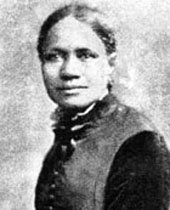| Why I Love Frances Harper “I am attracted to smart women. I am attracted to talented women. I am attracted to brave women. I married one and we live happily ever after. Then, six months ago, I was introduced to this amazing woman who lived just a few blocks from me. Her name is Frances Ellen Watkins Harper. Ok, so she died a hundred years ago, but that is not relevant. It is so much fun to fall in love. I love language. I love learning new things. I love history. Especially the history of the ongoing struggle to make this world, this country, this city the kind of place it should be: where we are free; where opportunity is not based on race, class or gender; where we take care of each other. And I love sharing. Now that I know Frances, I want everyone to know her.” – Larry Robin |
FRANCES E. W. HARPER
 Frances Ellen Watkins Harper’s story is one of bravery, creative excellence, political consciousness, activism, and determination during the period preceding, during, and after the Civil War.
Frances Ellen Watkins Harper’s story is one of bravery, creative excellence, political consciousness, activism, and determination during the period preceding, during, and after the Civil War.
- 1825 – Born Frances Ellen Watkins in Baltimore, Maryland, she was orphaned at the age of three and raised by her uncle, the abolitionist William Watkins.
- 1846 – She began her amazing career as a writer by publishing her first book of poetry, Forest Leaves, at the age of 21.
- 1853 – Frances Watkins first moved to Philadelphia after meeting William Still, in order to become active in the Underground Railroad.
- 1858 – She refused to give up her seat or ride in the “colored” section of a segregated trolley car in Philadelphia (100 years before Rosa Parks) and wrote one her most famous poems, “Bury Me In A Free Land,” when she got very sick while on a lecturing tour. Her short story “The Two Offers” became the first short story to be published by an African American.
- 1859 – A dedicated abolitionist, Harper was one of the few public figures who did not abandon John Brown after his failed effort at Harpers Ferry, instead writing to him and staying with his wife, Mary, at the home of Lucretia Mott (Philadelphia’s leading Quaker Abolitionist) for the two weeks preceding his hanging.
- 1860 – She married Fenton Harper, had a daughter, Mary, and was widowed in 1864.
- 1865 – In the immediate post-Civil War years, Harper returned to the lecture circuit, focusing her attentions on education for the formerly enslaved, on the Equal Rights Movement and on the Temperance Movement.
- 1868 – She spent four years speaking and teaching in churches and Freedmen’s schools in the South, stressing the importance of education and self-empowerment.
- 1892 – Harper published her most famous novel, Iola Leroy, at the age of 67. This novel, which was written in Philadelphia, was a best seller and is one of the few books from this period to look at the mid-nineteenth century American landscape through African-American eyes.
- 1896 – Frances Harper became Vice President of the newly formed National Association of Colored Women.
- 1911 – Frances Ellen Watkins Harper died on February 22, 1911.
Frances E.W. Harper is considered the “Mother of African American Journalism” as well as the most famous nineteenth century African American poet and novelist. In her role as a political activist, Frances Ellen Watkins Harper was a brave, principled, and talented advocate for freedom and equality for everyone, speaking for the Anti-Slavery societies before the Civil War and for Women’s Suffrage and Temperance movements after. The study of her life not only gives us a picture of the lived experiences of an intelligent, educated, African American woman in the nineteenth century, but also provides us with a snapshot of Philadelphia and the nation from a perspective that is not usually presented.
Despite all of her remarkable accomplishments, Frances E.W. Harper’s name cannot be found in most history books.

This introduction is well organized and clearly outlines the purpose of the article. The author offers a clear and concise overview of the topic, and provides an engaging introduction to the reader. This biography is a comprehensive and informative look at the life of the subject. The author clearly outlines the key points of the subject’s life, and provides an insightful narrative of the person’s experiences.
I love the way this blog is written – it’s clear, concise, and easy to understand.
I love the way this blog is written – it’s clear, concise, and easy to understand.
Your blog is a fantastic resource for anyone seeking knowledge and inspiration.
karacabey escort
Your blog’s approachable tone and conversational style make me feel like we’re old friends. I enjoy reading your posts as much as catching up with a dear companion.